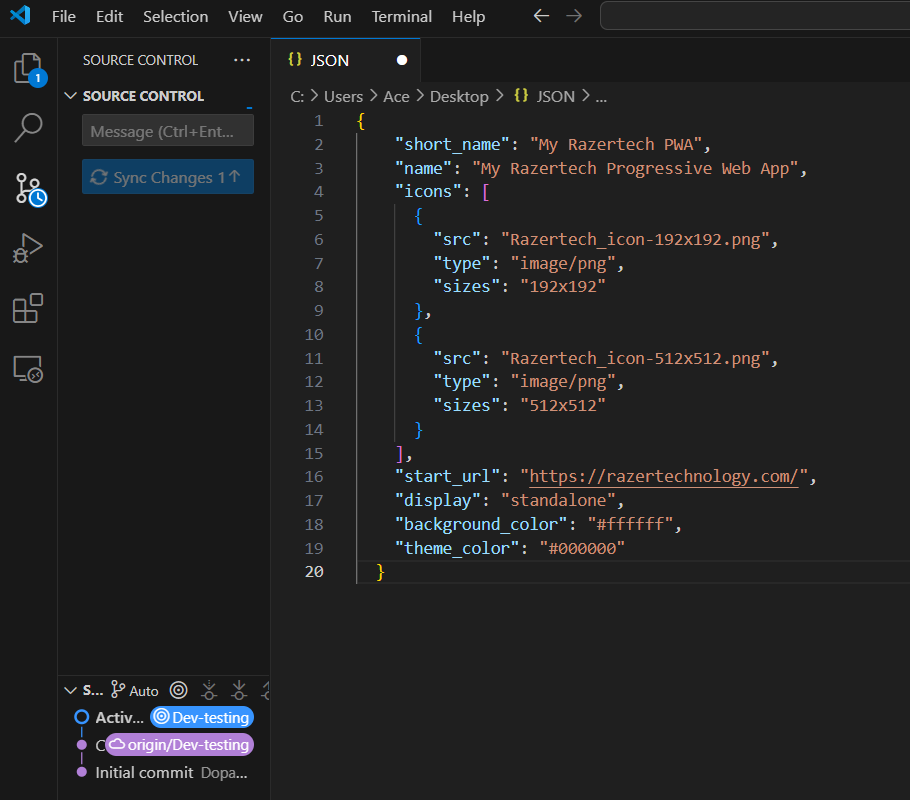
How to Integrate or Create a PWA (Progressive Web App)
As promised in our previous post, “What is a Progressive Web App?“, this article will guide you step-by-step on how to integrate a Progressive Web App (PWA) into your existing or new website. By the end of this guide, you’ll have the tools and knowledge to transform your site into a fully functional PWA, offering users an app-like experience. Let’s get started!
Here’s what we’ll cover:
- Create a Manifest File: Learn how to define your PWA’s metadata, such as its name, icons, and display behavior, using a
manifest.jsonfile. - Register a Service Worker: Understand how to set up a service worker to enable offline functionality and caching for your PWA.
- Link the Manifest and Register the Service Worker: Add the manifest file and service worker to your HTML to make your website PWA-ready.
- Add an Install Prompt (Optional): Implement a custom install prompt to encourage users to add your PWA to their home screen or desktop.
- Test Your PWA: Use tools like Lighthouse to test your PWA and ensure it meets all requirements.
Here’s a step-by-step guide with code snippets to help you get started:
The code snippets have been tested and are well commented, so they should help you understand and modify the code as needed! Good Luck Buddy.🚀
1. Create a Manifest File
The manifest.json file is essential for defining your PWA’s metadata, such as its name, icons, and display behavior.
{
"short_name": "Razertech", // Short name for the app
"name": "My Razertech Web App", // Full name of the app
"icons": [
{
"src": "Razertech icon-192x192.png", // Path to the icon file
"type": "image/png", // Icon file type
"sizes": "192x192" // Icon size
},
{
"src": "Razertech icon-512x512.png", // Path to the larger icon file
"type": "image/png", // Icon file type
"sizes": "512x512" // Icon size
}
],
"start_url": "https://razertechnology.com/", // The URL to load when the app starts
"display": "standalone", // How the app should be displayed (standalone, fullscreen, etc.)
"background_color": "#ffffff", // Background color for the splash screen
"theme_color": "#110ec5" // Theme color for the app
}2. Register a Service Worker
A service worker enables offline functionality and caching. Create a service-worker.js file:
// Define the cache name and files to cache
const CACHE_NAME = 'my-Razertech pwa-cache-v1';
const urlsToCache = [
'/', // Cache the root URL
'/styles/main.css', // Cache CSS files
'/scripts/main.js', // Cache JavaScript files
'/images/Razertech_logo.png' // Cache images
];
// Listen for the 'install' event to cache files
self.addEventListener('install', (event) => {
event.waitUntil(
caches.open(CACHE_NAME) // Open the cache
.then((cache) => cache.addAll(urlsToCache)) // Cache all specified files
);
});
// Listen for the 'fetch' event to serve cached files
self.addEventListener('fetch', (event) => {
event.respondWith(
caches.match(event.request) // Check if the request is in the cache
.then((response) => response || fetch(event.request)) // Serve from cache or fetch from network
);
});3. Link the Manifest and Register the Service Worker
Add the manifest file and register the service worker in your HTML:
<!DOCTYPE html>
<html lang="en">
<head>
<meta charset="UTF-8">
<meta name="viewport" content="width=device-width, initial-scale=1.0">
<title>My PWA</title>
<!-- Link to the manifest file -->
<link rel="manifest" href="/manifest.json">
</head>
<body>
<h1>Welcome to My Razertech PWA</h1>
<h2>
The home of SaaS, Tech, Design & Digital marketing solutions
</h2>
<script>
// Check if the browser supports service workers
if ('serviceWorker' in navigator) {
// Register the service worker
navigator.serviceWorker.register('/service-worker.js')
.then((registration) => {
console.log('Service Worker registered with scope:', registration.scope);
})
.catch((error) => {
console.error('Service Worker registration failed:', error);
});
}
</script>
</body>
</html>4. Add an Install Prompt (Optional)
To encourage users to install your PWA, you can trigger an install prompt:
let deferredPrompt; // Variable to store the install prompt event
// Listen for the 'beforeinstallprompt' event
window.addEventListener('beforeinstallprompt', (event) => {
event.preventDefault(); // Prevent the default prompt
deferredPrompt = event; // Store the event for later use
// Show your custom install button or prompt here
});
// Add a click event listener to your custom install button
document.getElementById('installButton').addEventListener('click', () => {
if (deferredPrompt) {
// Trigger the install prompt
deferredPrompt.prompt();
// Wait for the user to respond to the prompt
deferredPrompt.userChoice.then((choiceResult) => {
if (choiceResult.outcome === 'accepted') {
console.log('User accepted the install prompt');
} else {
console.log('User dismissed the install prompt');
}
deferredPrompt = null; // Clear the deferred prompt
});
}
});5. Test Your PWA
- Use Lighthouse in Chrome DevTools to test your PWA.
- Ensure your site is served over HTTPS (required for PWAs).



